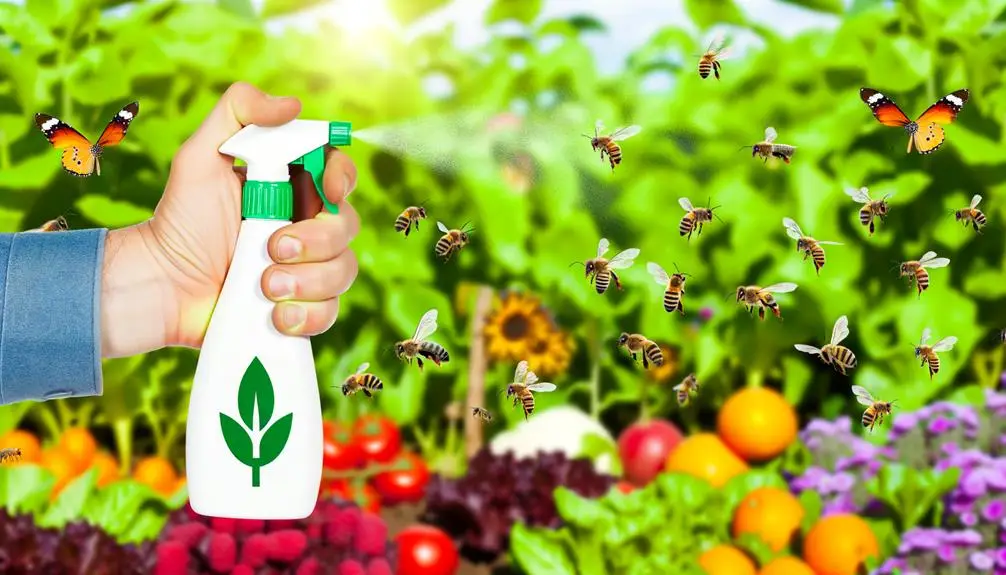Are Organic Pesticides Safe? Organic pesticides, sourced from natural materials, aren’t always free from risks. They promote sustainable agriculture with lower environmental persistence than synthetics, but misuse can lead to health hazards like allergic reactions. Beneficial insects and aquatic life might suffer if application is improper. Despite breaking down faster, they might still contaminate water or soil. Regulatory oversight varies, meaning adherence to health guidelines is essential. Comparison with synthetic pesticides shows they’re often environmentally more secure but less potent. Their impact on biodiversity necessitates careful application to maintain ecological balance. Exploring further will clarify their role and mitigate potential risks.
Key Takeaways
- Organic pesticides are derived from natural sources, including plants and microbes, and are generally considered environmentally safer than synthetic options.
- They break down quickly, reducing long-term environmental contamination, but misuse can still harm non-target organisms.
- Health risks from organic pesticides can include allergic reactions; proper handling and safety guidelines are essential.
- Organic pesticides may require more frequent application and can lead to pest resistance if overused.
- Regulatory standards for organic pesticides ensure safety through rigorous testing and monitoring for environmental and human health impacts.
Understanding Organic Pesticides
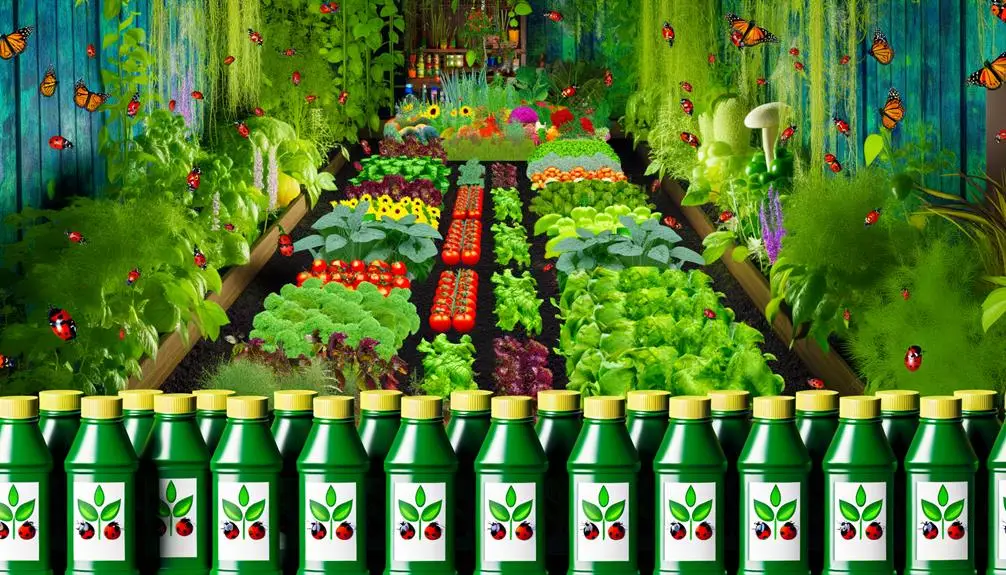
Understanding organic pesticides involves delving into their composition and mechanisms, which are distinct from conventional chemical pesticides. You’ll find that organic pesticides are derived from natural sources, such as plants, minerals, and microbes. These substances are an important component of natural pest control strategies, aiming to minimize environmental impact while effectively managing pest populations. For instance, companies like NaturePest specialize in holistic pest control services that utilize organic methods to guarantee security and sustainability. Organic pesticides are designed to work harmoniously within ecosystems, thereby supporting holistic solutions that integrate with broader agricultural practices.
In integrated pest management (IPM), organic pesticides play a significant role. IPM is a thorough approach that combines different management strategies and practices to control pest populations in an economically viable and environmentally sound manner. By incorporating organic pesticides, you contribute to a balanced ecosystem, fostering biodiversity and reducing the reliance on synthetic chemicals. This approach not only targets pests but also considers the health of crops, beneficial organisms, and surrounding habitats.
Organic pesticides often operate through mechanisms such as disrupting insect life cycles, repelling pests, or enhancing plant resistance. For instance, neem oil, a common organic pesticide, inhibits insect growth and reproduction. Understanding these mechanisms can help you make informed decisions about pest management in your own garden or farm.
As you embrace natural pest control methods, you join a community that values sustainability and environmental stewardship. By choosing organic pesticides, you’re not only protecting your crops but also contributing to a healthier planet. This shared commitment to eco-friendly practices fosters a sense of belonging and shared responsibility within the agricultural community.
Common Types of Organic Pesticides
When exploring common types of organic pesticides, you’ll find several options derived from natural sources that effectively manage pest populations. Among these, essential oils stand out due to their multifunctional properties. Extracted from plants like peppermint and neem, essential oils serve as a natural pest control solution. They disrupt insects’ nervous systems and deter them through strong scents, providing a natural alternative to synthetic chemicals. Additionally, eco-friendly products reduce chemical exposure in homes, making them a more secure choice for families and pets. These oils can be applied in various ways, such as sprays or diffusers, making them versatile tools for both indoor and outdoor use. For homeowners looking to incorporate nonchemical pest control tips, combining essential oils with practices like sealing entry points or maintaining proper sanitation can greatly enhance their effectiveness. By adopting these strategies, you can create a pest-free environment without compromising safety or sustainability.
Another popular organic pesticide is diatomaceous earth, a powdery substance composed of fossilized algae. It works by physically abrading the exoskeletons of insects, leading to dehydration and death. This method aligns with integrated pest management (IPM) strategies, targeting pests without harming beneficial organisms.
Bacillus thuringiensis (Bt) is a bacterium-based pesticide that specifically affects caterpillars and larvae. When ingested, it produces proteins toxic to these pests, offering a precise and environmentally friendly approach within IPM frameworks.
In the domain of botanical insecticides, pyrethrin, extracted from chrysanthemum flowers, is notable for its rapid action against a wide range of insects. Its biodegradability makes it a preferred choice for those seeking sustainable pest control methods.
Benefits of Organic Pesticides

Organic pesticides offer a multitude of benefits due to their natural origin and reduced environmental impact. When you choose organic options, you’re embracing substances that often break down more quickly in the environment, decreasing the likelihood of long-term contamination. This quality is particularly advantageous in ecologically sensitive areas such as South Florida, where maintaining biodiversity is essential. In Broward County, Florida, where the Everglades and unique ecosystems thrive, the use of organic pesticides supports the preservation of native species and habitats. Additionally, eco-friendly pest control methods, like eco-friendly ant control, align with sustainable practices that guarantee minimal disruption to the environment.
Organic pesticides are generally derived from botanicals, minerals, and microbial agents, which contribute to their biocompatibility. These natural substances often target specific pests, reducing the risk of harming beneficial insects and promoting a balanced ecosystem. For example, neem oil, a popular organic pesticide, disrupts the life cycle of pests without affecting pollinators like bees, which are crucial for the flourishing flora in Florida’s landscapes.
Moreover, by integrating organic pesticides, you’re aligning with agricultural practices that prioritize soil health. These products typically support soil microbes and organic matter, enhancing soil structure and fertility. This sustainable approach guarantees that the rich agricultural heritage of South Florida remains viable for future generations.
In an era where consumers are increasingly conscious about environmental stewardship, adopting organic pesticides can foster community trust and engagement. As you participate in local agricultural practices or community gardening in Broward County, embracing organic methods not only contributes to ecological sustainability but also reinforces a sense of collective responsibility for the environment.
Potential Risks Involved
While the benefits of organic pesticides are numerous, it’s equally important to recognize the potential risks involved with their use. Organic pesticides, although derived from natural sources, can still pose threats to both human health and the environment. In Miami Dade County, where agricultural activities are prevalent, understanding these risks is essential for responsible pesticide application.
Firstly, certain organic compounds can cause allergic reactions or toxicity in humans if improperly handled. For instance, substances like rotenone and pyrethrum, commonly used organic pesticides, can lead to respiratory issues upon inhalation. Furthermore, organic pesticides may not be fully selective, potentially affecting non-target organisms, including beneficial insects like bees and butterflies, which are crucial to local ecosystems.
The table below highlights key potential risks associated with organic pesticide use:
| Risk Factor | Description |
|---|---|
| Human Health | Allergic reactions, respiratory issues |
| Non-target Organisms | Harm to beneficial insects and wildlife |
| Environmental Impact | Potential contamination of water and soil |
| Resistance Development | Pests developing resistance over time |
| Inconsistent Regulations | Varied guidelines across regions |
Environmental contamination is another concern, as organic pesticides can leach into the soil and water systems if not applied judiciously. This could result in unintended harm to aquatic life and soil microorganisms, disrupting the balance of Miami Dade County’s ecological systems.
Additionally, over-reliance on any pesticide, organic or synthetic, can lead to pest resistance. This necessitates integrated pest management strategies to maintain long-term effectiveness. By remaining informed and adhering to best practices, you contribute to a sustainable and responsible approach to pest control in your community.
Comparing Organic and Synthetic Pesticides

Understanding the differences between organic and synthetic pesticides is vital for making informed decisions about pest management. As someone who values community and environmentally conscious practices, it’s important to recognize how these two categories differ in composition and application. Organic pesticides are typically derived from natural sources like plants, minerals, or microbes, whereas synthetic pesticides are chemically formulated. Additionally, using holistic pest control methods can enhance the effectiveness of organic options while minimizing environmental impact. Let’s explore how these differences manifest:
- Mode of Action: Organic pesticides often target specific pests by disrupting their life cycles or deterring them through natural compounds. Synthetic pesticides, however, generally employ broader-spectrum agents that can eliminate a wide range of pests, potentially affecting non-target organisms.
- Persistence: Organic pesticides tend to break down more quickly in the environment, reducing residual exposure. In contrast, synthetic pesticides may persist longer, leading to prolonged environmental and potential human exposure.
- Toxicity: While both types of pesticides can pose risks, synthetic pesticides are often associated with higher toxicity levels. Organic options are usually perceived as less harmful, yet it’s important to remember that “natural” doesn’t always equate to non-toxic.
- Regulation and Approval: The regulatory process for organic pesticides can be less stringent, relying on naturally occurring substances. Synthetic pesticides undergo rigorous testing to assess their efficacy and safety, which can provide a level of assurance but doesn’t negate potential risks.
Environmental Impact
Examining the environmental impact of pesticides reveals significant differences between organic and synthetic options. As you explore this topic, you’ll find that organic pesticides often boast a more favorable environmental profile. They’re typically derived from natural sources, such as plants, minerals, or microorganisms, which can lead to reduced persistence in ecosystems. This means they break down more quickly, minimizing long-term negative effects on non-target species and soil health. Additionally, companies like NaturePest offer organic-compliant and natural pest control methods that guarantee protection for both people and the environment.
In contrast, synthetic pesticides are frequently designed for durability, guaranteeing prolonged effectiveness against pests. However, this persistence can result in accumulation in the environment, potentially leading to biodiversity loss and disruption of ecological balance. For example, synthetic chemicals like neonicotinoids have been linked to declines in pollinator populations, a vital component of ecosystem stability.
It’s important to reflect on the specificity of organic pesticides. They often target a narrower range of pests, reducing collateral damage to beneficial organisms such as pollinators and natural pest predators. This selectivity can foster an environment where these beneficial species thrive, enhancing natural pest control mechanisms and reducing the need for chemical interventions.
However, it’s not all positive for organic options. You must be aware that some organic pesticides, like copper-based compounds, can accumulate in the soil if used excessively, potentially harming soil organisms and plant health. Balancing their use is essential to maintain environmental integrity.
Health Implications for Humans
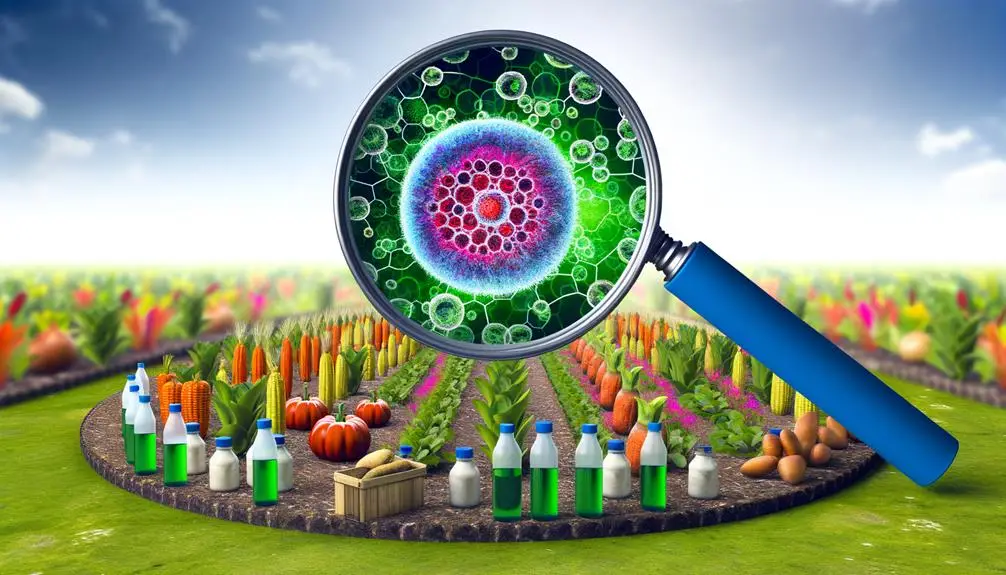
As you consider the environmental benefits of organic pesticides, it’s also essential to assess their health implications for humans. While organic pesticides are derived from natural sources, this doesn’t automatically guarantee security. You need to examine their chemical composition and potential health effects. Organic pesticides can contain bioactive compounds capable of affecting human health, especially with prolonged exposure or misuse.
Here’s what you should consider:
- Exposure Routes: Organic pesticides can enter your body through inhalation, skin contact, or ingestion. Understanding these routes helps in employing effective protective measures during application.
- Acute Toxicity: Some organic pesticides, like rotenone or pyrethrins, may cause immediate adverse effects such as skin irritation, respiratory discomfort, or eye irritation. Being aware of these reactions can help in prompt identification and management.
- Chronic Effects: Long-term exposure to certain organic pesticides might pose health risks, including potential carcinogenicity or neurotoxicity. It’s critical to evaluate the available research and regulatory assessments to understand these risks.
- Regulatory Oversight: The regulation of organic pesticides varies by region. Agencies like the EPA in the U.S. evaluate pesticides for security, but compliance with safety guidelines is essential for minimizing health risks.
Effects on Non-Target Species
Organic pesticides, often lauded for their environmental friendliness, can inadvertently impact non-target species. You might assume these products solely affect pests, but evidence indicates otherwise. Non-target species, such as beneficial insects, birds, and aquatic life, can unintentionally suffer from exposure to these substances. The impact varies based on the pesticide’s active ingredients and application methods. For instance, neem oil, a common organic pesticide, can disrupt the life cycles of beneficial insects like bees and butterflies.
Understanding the effects on non-target species requires examining specific interactions:
| Pesticide Type | Affected Non-Target Species |
|---|---|
| Neem Oil | Bees, beneficial insects |
| Pyrethrins | Aquatic organisms, birds |
| Rotenone | Fish, amphibians |
Each pesticide has unique properties that determine its ecological footprint. Pyrethrins, derived from chrysanthemum flowers, can be toxic to aquatic life if they enter water systems due to runoff. Similarly, rotenone, a naturally occurring compound from certain plant roots, has been shown to harm fish and amphibians through water contamination.
It’s essential to recognize that while organic pesticides reduce certain risks associated with synthetic chemicals, they still pose challenges. Ensuring that their use aligns with environmental stewardship involves choosing application methods that minimize exposure to non-target species. You, as a conscientious member of the community, can contribute by advocating for integrated pest management strategies that prioritize ecological balance. By doing so, you help foster a sense of belonging with like-minded individuals dedicated to sustainable practices and the preservation of biodiversity.
Regulatory Standards for Safety

To guarantee the protection of organic pesticides, regulatory standards play a critical role in safeguarding both human health and the environment. As a consumer, it’s important to understand how these standards function to verify that the products you use meet stringent security criteria. Regulatory agencies conduct thorough evaluations to establish permissible levels of pesticide residues in food, confirming these levels don’t pose a risk to consumers. The process involves examining toxicological data, environmental impact studies, and potential exposure scenarios.
When it comes to organic pesticides, several key regulatory considerations are in place:
- Registration and Approval: Organic pesticides must undergo a rigorous registration process, often requiring substantial scientific data to demonstrate their security and efficacy. This verifies that only products meeting high security standards reach the market.
- Maximum Residue Limits (MRLs): MRLs define the maximum concentration of pesticide residues legally allowed in or on food. These limits are set based on thorough risk assessments and are regularly reviewed to reflect new scientific findings.
- Environmental Impact Assessment: Regulators assess the potential environmental effects of organic pesticides, including their impact on non-target species and ecosystems. This assessment helps minimize adverse environmental outcomes.
- Compliance and Monitoring: Continuous monitoring and compliance checks are essential. Regulatory bodies conduct inspections and testing to verify that manufacturers adhere to security standards and that products on the market remain within legal limits.
Misconceptions About Organic Pesticides
Many people mistakenly believe that organic pesticides are inherently more reliable and less harmful than synthetic ones. However, this perception often overlooks the complexity and potential risks associated with organic compounds. When you consider that both organic and synthetic pesticides are designed to eliminate pests, it’s vital to understand that toxicity doesn’t inherently correlate with whether a substance is organic or synthetic.
Organic pesticides can contain potent natural chemicals, such as pyrethrins, which are derived from chrysanthemums. These compounds are effective but can be toxic to beneficial insects and aquatic life. To make informed decisions, you should evaluate the toxicity profile of each pesticide, regardless of its origin. Research indicates that some organic pesticides can also pose risks to human health if misapplied or overused. For example, rotenone, a natural compound, has been associated with certain health concerns upon exposure.
Furthermore, the belief that organic pesticides break down more quickly and reliably in the environment than their synthetic counterparts isn’t always accurate. Environmental persistence varies greatly depending on the specific chemical properties of each pesticide and environmental conditions. Therefore, assuming organic options are universally safer can lead to unintended ecological consequences.
In working toward sustainable agriculture, it’s essential to critically assess all pest control options. By understanding the nuanced differences and risks of each pesticide, you can make choices that align with both environmental reliability and pest management goals. This approach fosters a more informed and inclusive community dedicated to sustainable practices.
Case Studies on Organic Pesticide Use
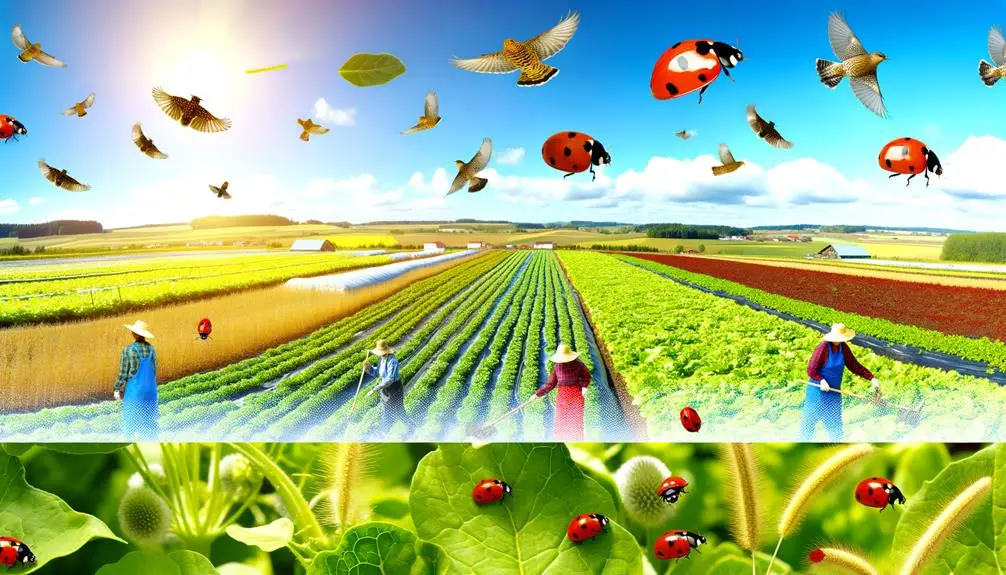
While misconceptions about organic pesticides persist, real-world applications provide a clearer picture of their complexities. By examining case studies, you can gain insight into how these substances perform in diverse agricultural settings. Understanding the nuanced outcomes of organic pesticide use helps bridge the gap between perception and reality, offering a more grounded perspective.
- Efficacy in Pest Control: A study in New Zealand investigated the efficacy of neem oil, a popular organic pesticide, in controlling aphid populations on organic farms. Results indicated a significant reduction in aphid numbers, demonstrating its potential as an effective pest management tool. However, variability in application techniques affected outcomes, highlighting the importance of consistent usage protocols.
- Environmental Impact: In California, researchers evaluated the ecological effects of using pyrethrin-based pesticides in vineyards. While pyrethrins are derived from chrysanthemums, their application led to unintended consequences on beneficial insect populations. This case underscores the necessity for thorough impact assessments when adopting organic solutions.
- Human Health Considerations: A case study in India focused on the health implications of using copper sulfate in organic rice cultivation. The study revealed that while copper sulfate minimized pest damage, prolonged exposure posed risks to farm workers’ health. This emphasizes the need for protective measures and awareness of potential health hazards.
- Economic Viability: An analysis in Kenya assessed the economic sustainability of using Bacillus thuringiensis (Bt) on smallholder farms. Findings showed that while initial costs were higher, long-term savings from reduced crop losses justified the investment, illustrating the potential financial benefits of organic pesticide adoption.
These case studies reflect the multifaceted nature of organic pesticide use, advocating for informed decision-making grounded in empirical evidence.
Best Practices for Safe Use
In guaranteeing the secure use of organic pesticides, it’s essential to adhere to established guidelines that enhance both efficacy and protection. First, you’ll want to thoroughly review the manufacturer’s instructions and safety data sheets before application. These documents provide significant information on proper usage, potential hazards, and necessary protective equipment. Always wear appropriate personal protective gear, such as gloves and masks, to minimize direct exposure.
When handling organic pesticides, proper storage is important. Keep them in a cool, dry place, out of reach of children and pets, to prevent accidental ingestion or contact. It’s also important to mix only the amount you need for immediate use, as organic pesticides can degrade over time, reducing their effectiveness and possibly altering their protection profile.
Application techniques matter, too. Use targeted application methods, such as spot spraying or soil injection, to minimize environmental impact and reduce non-target exposure. Avoid applying pesticides during windy conditions, as drift can carry chemicals to unintended areas, potentially harming beneficial organisms and ecosystems.
Regular equipment maintenance guarantees that your spraying tools function efficiently, preventing leaks and ensuring even distribution. Calibration of equipment helps achieve the intended application rate, avoiding overuse, which could lead to resistance or unintended damage to plants.
Lastly, monitoring and record-keeping are essential. Document each pesticide application, including the product used, date, weather conditions, and observed outcomes. This information aids in evaluating efficacy and protection, fostering a community of informed users committed to sustainable and secure pest management practices. By following these best practices, you contribute to a more secure environment while effectively managing pests.
Organic Certification and Labels
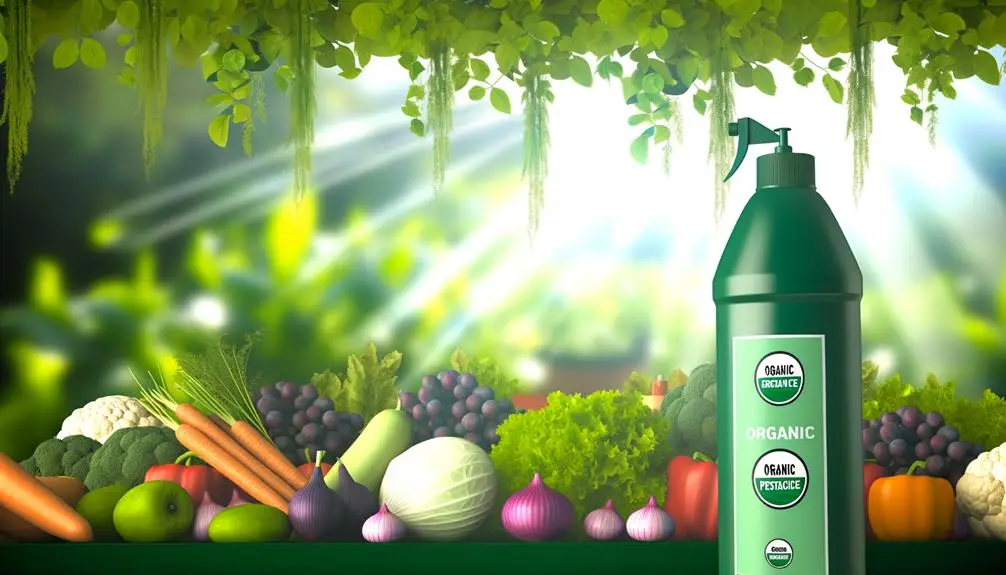
Organic certification and labeling play an essential role in guaranteeing the integrity and trustworthiness of organic pesticides. When you’re selecting organic products, these certifications provide a sense of security, reassuring you that the products meet established organic standards. The certification process involves rigorous evaluation and adherence to specific guidelines designed to maintain ecological balance and biodiversity while minimizing synthetic inputs. By understanding the certification and labeling system, you can make informed decisions and feel confident that you’re supporting sustainable agricultural practices.
Here’s what you need to know about organic certification and labels:
- Certification Bodies: Organizations like the USDA in the United States and the Soil Association in the UK are responsible for certifying products as organic. They guarantee compliance with national and international organic standards.
- Labeling Requirements: Certified organic products must display specific labels indicating their organic status. These labels assure that the product has undergone thorough evaluation by a recognized certification body.
- Standards Compliance: Organic certification standards typically restrict the use of synthetic fertilizers, genetically modified organisms (GMOs), and certain pesticides, guaranteeing that organic pesticides contain ingredients derived from natural sources.
- Consumer Assurance: By purchasing certified organic pesticides, you’re supporting practices that prioritize environmental health and sustainability, aligning with a community that values responsible stewardship of natural resources.
Understanding these aspects of organic certification and labels empowers you to contribute to a community committed to sustainable agriculture. When you choose certified organic pesticides, you’re not just buying a product; you’re participating in a movement that values authenticity and ecological responsibility.
Perspectives From Experts
Understanding organic certification and labels equips you to engage responsibly with sustainable agricultural practices. As you explore the security of organic pesticides, it’s essential to reflect on the insights provided by experts in the field. Researchers and agricultural scientists emphasize that organic pesticides, although derived from natural sources, are not inherently harmless. Their effectiveness and environmental impact depend on specific active compounds and application methods.
Experts argue that organic pesticides like neem oil, pyrethrin, and sulfur-based compounds can pose risks similar to synthetic pesticides if misused. Toxicologists highlight that compounds such as rotenone, historically used in organic farming, have been scrutinized for potential health risks. Data indicate that some organic pesticides could have unintended ecological consequences, affecting non-target organisms, including beneficial insects and soil microbiota.
Agronomists underscore the importance of integrated pest management (IPM) strategies, which prioritize natural pest control methods and minimize pesticide reliance, whether synthetic or organic. This approach fosters a sustainable agricultural ecosystem, promoting biodiversity and reducing chemical inputs. Adopting IPM can enhance your understanding of pest dynamics and encourage more secure pesticide practices.
Moreover, regulatory bodies like the Environmental Protection Agency (EPA) and European Food Safety Authority (EFSA) rigorously evaluate the security of organic pesticides. They provide guidelines on their use, ensuring that they meet safety standards before market approval. By staying informed on these expert perspectives, you join a community committed to advancing sustainable agriculture while prioritizing health and environmental integrity. This collective knowledge drives innovation and responsible choices in organic farming practices.
Future of Organic Pesticides

As the agricultural industry evolves, the future of organic pesticides holds promise for advancing sustainable farming practices. This progression hinges on leveraging cutting-edge research and technology to enhance pest control efficacy while minimizing environmental impact. As you’re part of a community that values sustainability, it’s crucial to understand how these advancements can shape the future of agriculture.
- Biopesticides Development: The future will likely see an increase in the development of biopesticides derived from natural materials such as plants, bacteria, and certain minerals. These are designed to target specific pests, reducing unintended harm to beneficial organisms.
- Genomic Innovations: Genetic advancements hold the potential to improve the resistance of crops to pests. By integrating genomic technologies, you can expect more resilient organic crops, reducing the dependency on external pesticides.
- Precision Agriculture: The use of data-driven farming techniques can optimize pesticide application. Precision agriculture enables you to apply organic pesticides only where needed, conserving resources and reducing environmental footprint.
- Regulatory Support: Increased governmental support and clear regulations can foster innovation. By aligning with these frameworks, the industry can guarantee that new organic pesticides meet standards of security and efficacy, offering reassurance to you as a consumer.
Collectively, these innovations can enhance the sustainability and security of organic pesticides. As part of this community, your awareness and support of these advancements can contribute to a more sustainable agricultural future, guaranteeing that the food systems remain secure and environmentally friendly.
Frequently Asked Questions
Can Organic Pesticides Affect the Taste of Fruits and Vegetables?
When you’re concerned about organic pesticides impacting the taste of fruits and vegetables, it’s essential to contemplate the type and concentration used. Some organic pesticides may alter flavors slightly due to their natural compounds. However, proper application techniques minimize any taste changes, ensuring produce retains its natural flavor. Joining a community of organic gardeners can provide insights and shared experiences, reinforcing the importance of careful usage for best results.
Are Organic Pesticides Effective Against All Types of Pests?
You’ll find that organic pesticides aren’t universally effective against all pests. In fact, about 30% of pests might resist them due to their targeted nature. While some organic options work well for specific insects or diseases, they lack the broad-spectrum impact of synthetic pesticides. It’s essential to integrate them into a thorough pest management plan. This approach guarantees that your efforts align with community values, supporting both environmental health and agricultural productivity.
How Long Do Organic Pesticides Remain Active on Plants?
You’ll find that the persistence of organic pesticides on plants varies considerably, typically remaining active from a few days to a couple of weeks. Factors influencing their duration include the type of pesticide, environmental conditions like rainfall and sunlight, and plant surface characteristics. Regular monitoring and reapplication may be necessary to maintain effectiveness. By understanding these dynamics, you can better integrate organic pesticides into your sustainable pest management practices.
Do Organic Pesticides Require Special Storage Conditions?
You’ve probably heard that organic pesticides need special storage, and it’s true. They often require cool, dry places away from direct sunlight to maintain their effectiveness. This isn’t just about security; it’s about being part of a community that values sustainable practices. Proper storage keeps them potent and guarantees they work as intended, supporting the collective goal of eco-friendly pest management. It’s a shared responsibility we all embrace.
Can Organic Pesticides Be Used in Home Gardens Safely?
You can securely use organic pesticides in home gardens by adhering to certain guidelines. Follow the manufacturer’s instructions about application rates and timings to guarantee effectiveness without harming beneficial organisms. Properly store them in cool, dry places to maintain efficacy. Regularly monitor plants for pest activity and use integrated pest management practices. Engaging with gardening communities can provide shared insights and experiences, enhancing your approach and fostering a sense of belonging.
Create a Truly Sustainable Garden
In your quest for a vibrant, eco-friendly garden, choosing the right pest control is essential. While organic pesticides are a popular, toxin-free option, they’re not always impact-free. At NaturePest Holistic Pest Control, we champion Integrated Pest Management (IPM) to help you make informed, balanced choices that protect both your plants and the surrounding ecosystem. This approach combines preventive measures, biological controls, and targeted treatments to minimize harm while effectively managing pests. By embracing holistic pest control solutions, you can create a thriving garden that nurtures biodiversity and reduces reliance on harsh chemicals. Together, we aim to strike a perfect balance that safeguards your plants and promotes a healthier environment for all living organisms.
With our expert guidance, you can navigate the nuances of organic pest control, ensuring a garden that’s green in every sense—safe, effective, and environmentally conscious. Call us today to cultivate a garden that’s generous to the environment and truly sustainable!

